Posted in: Aha! Blog > Eureka Math Blog > Implementation Support > Extending Your Classroom Community with Family Resources
When I taught Eureka Math®, I wanted a strong partnership between the classroom and my students’ at-home experiences. The families of my third graders were invested in their success but they often had questions about using a math program that looked a bit different from the way they learned math.
As a busy teacher, I needed some help answering those questions. Maybe you do, too. Fortunately, Eureka Math has a variety of resources you can easily share with your larger classroom community. These resources address common questions, and they help students and their families expand their understanding of math. Add these resources to your greatminds.org account so that you can access them anytime. Let me tell you about a couple of my favorites.
Parent Tip Sheets Parent Tip Sheets foster the connection between the classroom and families. They are free and are available in both English and Spanish for Kindergarten through Grade 8 within every topic in a module.
Parent Tip Sheets foster the connection between the classroom and families. They are free and are available in both English and Spanish for Kindergarten through Grade 8 within every topic in a module.
Using the Parent Tip Sheets will help families discover what their student is learning in the classroom and how they can support that work at home.
Don’t let the name fool you. Parent Tip Sheets are for anyone who supports your students with math. Share them with your students’ tutors, siblings, grandparents, babysitters, or even their neighbor who helps with math homework. Pass them along to your colleagues, like special education teachers, teachers of English learners, or teachers from different departments. The possibilities go way beyond the name.
What’s in a Parent Tip Sheet?

The Key Concept Overview provides a quick summary of what students learn in the topic. It previews the concepts and skills they will see on upcoming homework assignments.
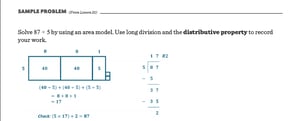 The Sample Problem shows an example of student work for a common problem type in the topic. This helps families understand what students’ work might look like.
The Sample Problem shows an example of student work for a common problem type in the topic. This helps families understand what students’ work might look like.
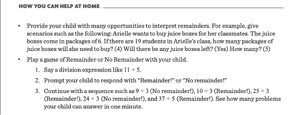 The How You Can Help at Home section provides ideas for family activities like games, discussion questions, and problems to solve. Families can use this section to support classroom learning and to build students’ interest in math.
The How You Can Help at Home section provides ideas for family activities like games, discussion questions, and problems to solve. Families can use this section to support classroom learning and to build students’ interest in math.
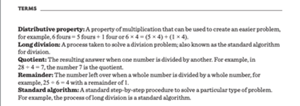 The Terms section lists the vocabulary students use in math class. Definitions are given for each term to help everyone use the words in the same way.
The Terms section lists the vocabulary students use in math class. Definitions are given for each term to help everyone use the words in the same way.
 The Models section builds an understanding of mathematical models students may use to solve problems. It shows what the model looks like and describes when it’s used.
The Models section builds an understanding of mathematical models students may use to solve problems. It shows what the model looks like and describes when it’s used.
How should you share Parent Tip Sheets?
- Show families how to create their own greatminds.org account and how to download Parent Tip Sheets during back-to-school nights.
- Place them in weekly take-home folders as each new topic begins.
- Print all the Parent Tip Sheets for a module (or half a module) and send them home stapled together.
- Share them with special education teachers, teachers of English learners, and other colleagues.
- Distribute them in any way that works for your students and community. The key to their effective use is providing a clear, dependable way to access each Parent Tip Sheet.
How can you foster the use of Parent Tip Sheets at home?
- Reference them in other communication (e.g., newsletters and quarterly conferences).
- Select a day of the week to discuss students’ experiences with the at-home activities during a morning meeting or other classroom community time.
- Annotate the Parent Tip Sheets with points you want to highlight (e.g., the date the material will be covered).
Family Math Night
Hosting a Family Math Night is a great way to get the community involved with Eureka Math. The Family Math Night resource has everything you need to hold an event with your community, and it’s free!
What’s in the Family Math Night resource?
The resource includes everything you need to host a Family Math Night at your school.
- A guide with an overview of all resources
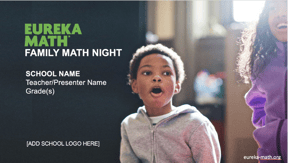
- Step-by-step instructions for getting started
- Templates, including invitations, flyers, and a follow-up letter and survey
- A presentation containing embedded videos that you can customize with your school’s information
- Session templates and handouts
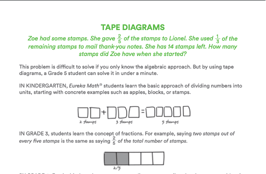
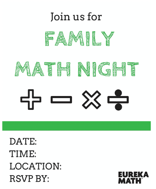 Post the premade flyers around your school’s hallways and by the entrance to build excitement for Family Math Night.
Post the premade flyers around your school’s hallways and by the entrance to build excitement for Family Math Night.- Send invitations to families by using the templates.
- Email families the night before with an additional reminder invitation.
- Encourage students to invite the adults in their families.
- Set up stations where families can experience Eureka Math
- Let your students show off all they’ve learned! Ask students to teach their family members how to use models or strategies.
- Post student work around the room to celebrate all that your students have accomplished.
- Print and share resources such as Grade Level Roadmaps that give a year-long learning overview.
Submit the Form to Print
.png)
Denise Dierolf
Denise Dierolf is a Eureka Math Implementation Leader. She provides professional development and implementation support to schools and districts using Eureka Math across the country. Previously, she taught third grade and served as an instructional coach and assistant principal in Washington, DC.
Topics: Implementation Support


.png?width=73&name=image%20(4).png)








